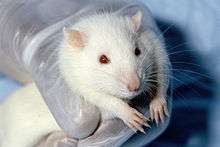Cruelty-free

In the animal rights movement, cruelty-free is a label for products or activities that do not harm or kill animals. Products tested on animals are not considered cruelty-free, since these tests are often painful and cause the suffering of millions of animals every year.[1]
“Every product, every action, and every lifestyle decision can be a choice to harm less.”— Zoe Weil, The Animals' Agenda[2]
History

The term cruelty-free was first used in this way by Lady Dowding who persuaded manufacturers of fake furs to use the label Beauty Without Cruelty and went on to found the charity Beauty Without Cruelty in 1959.[3] The term was popularised in the USA in the 1970s by Marcia Pearson who founded the group Fashion With Compassion.[4]
Campaigns
In 1957 Charles Hume and William Russell introduced the concept of the three R’s in their book Principles of Humane Experimental Technique. These techniques to reduce animals used in tests and their suffering include: replacement (eliminate an animal test altogether), reduction (less animals used in test by using statistical analysis) and refinement (making tests less painful).[5]
In 1991 the European Center for the Validation of Alternative Methods (ECVAM) was established, “...to promote the scientific and regulatory acceptance of alternative methods which are important to the biosciences and which reduce, refine or replace the use of laboratory animals.”<refCurren, Roger (Nov–Dec 2000). "From inhumane to in vitro: The changing face of science.". The Animals' Agenda. 20 (6): 22. Retrieved March 30, 2013./> Once the ECVAM’s Scientific Advisory Committee approves a test it must be used under the Animal Protection Act, which does not allow the use of animals when an alternative exists.
In 2012, British Union for the Abolition of Vivisection joined forces with New England Anti-Vivisection Society and the European Coalition to End Animal Experiments to create an international organization to campaign against animal testing. BUAV supporter Ricky Gervais[6] announced the campaign—now considered a deciding factor in the European decision to ban animal testing for personal-care products. Though companies can still use animal testing in countries outside Europe (such as China, which requires animal testing on all imported cosmetics), the Leaping Bunny applies to a company’s global market, and does not certify product that use animal testing anywhere in the world.
Tests
Animals such as rabbits, rats, mice, and guinea pigs are forced to eat or inhale substances, or have a cosmetic ingredient rubbed onto their shaved skin, eyes or ears every day for 28 or 90 days to see if they have an allergic reaction. Then they are killed and cut open to examine the effects the ingredient has on internal organs. These tests are also done with pregnant animals who, after much suffering, are killed along with the fetus. In more prolonged carcinogen tests, rats are force-fed a cosmetic ingredient over two years, monitored for cancer, and then killed.[7]
“Typically a young rabbit is tightly constrained in a box so that he is unable to move... Clips sometimes hold his eyelids open. Anesthesia is not generally administered. A researcher applies a concentrated substance to the outer layer of the eye and observes over a span days or weeks for responses such as blindness, bleeding, hemorrhaging and ulceration. At the end the rabbits are generally killed.”— Megan Erin Gallagher, Student Article[8]
Alternatives
As technology developed, outdated animal testing is being replaced with quicker, cheaper and more accurate methods. Critics point out that humane alternatives can be slow to implement, costly, and test only one compound at a time.[9] Alternatives have shown positive results. For example, reconstructed human epidermis—which uses human skin donated from cosmetic surgery to replace the rabbit Draize skin test—is more relevant to human reactions. Other methods replace the Draize eye test by using in vitro (test-tube) human tissue. Computer-based systems allow for isolation of a select tissue or organ to conduct tests in an extremely controlled environment. These tests not only save countless animal lives, but are more precise and accurate at protecting humans from toxic substances.[10] Another cruelty-free option is using ingredients that have already been established as safe, such as the 20,000 ingredients in the European Union database.

Products
Companies now offer a wide range of cruelty-free products such as cosmetics, personal-care products, household cleaners, clothing, shoes, condoms (which are sometimes processed with casein), and candles (which usually use paraffin or beeswax). Organizations such as PETA, Choose Cruelty Free, Coalition for Consumer Information on Cosmetics, British Union for the Abolition of Vivisection, and its offshoot organization Cruelty Free International have released lists of cruelty-free products and cruel products to boycott. Since the 1990s the Leaping Bunny has been the only international third-party cruelty-free certification program.
"With these synthetic brushes you no longer have to choose between being socially conscious and sacrificing quality or performance."
Events
National Cruelty-Free Week is an event in the United Kingdom every year arranged by the BUAV. The 2006 event was from 17–23 July. Other, similar, events include: National Vegetarian Week, UK Vegan Week and World Vegan Day, which takes place each year on November 1.
Criticisms
While some manufacturers have begun to label their products as “not tested on animals”, “we do not conduct animal testing”, “never tested on animals”, “against animal testing” or “cruelty-free”, these labels are confusing and potentially misleading since there is no clear legal definition as to what they mean.[12]
See also
References
- ↑ Andre, Claire; Velasquez, Manuel. "Of Cures and Creatures Great and Small". Santa Clara University. Retrieved 22 December 2014.
- ↑ Weil, Zoe (Jul–Aug 2001). "Consumerism and Animals". The Animals' Agenda. 21 (4): 42. Retrieved March 30, 2013.
- ↑ Encyclopedia of animal rights and animal welfare, 1998, p. 139, ISBN 978-0-313-29977-3
- ↑ Joanne Stepaniak, Virginia Messina (2000), "The Body Beautiful", The Vegan Sourcebook, McGraw-Hill Professional, ISBN 978-0-7373-0506-7
- ↑ Balls, Michael (7 January 1994). "Replacement of animal procedures: alternatives in research, education and testing". Laboratory Animals (London). 28 (3): 193–211. doi:10.1258/002367794780681714. PMID 7967458.
- ↑ Caroline Frost (15 March 2012), "Ricky Gervais Fronts Cruelty Free International Crusade To End Cosmetic Tests On Animals", Huffington Post
- ↑ "Animal Tests & Alternatives". Cruelty Free International. Retrieved March 30, 2013.
- ↑ Gallagher, Megan Erin (2003). Toxicity Testing Requirements, Methods and Proposed Alternatives. California: environs environmental law and policy journal. p. 253.
- ↑ Curren, Roger (Nov–Dec 2000). "From inhumane to in vitro: The changing face of science.". The Animals' Agenda. 20 (6): 22. Retrieved March 30, 2013.
- ↑ Curren, Roger (Nov–Dec 2000). "From inhumane to in vitro: The changing face of science.". The Animals' Agenda. 20 (6): 22. Retrieved March 30, 2013.
- ↑ Detweiler, Rachelle (Mar–Apr 2000). "I can't believe it's vegan!". The Animals' Agenda. 20 (2): 53. Retrieved 30 March 2013.
- ↑ Winders, Delcianna (2006). "Combining Reflexive Law and False Advertising Law to Standardize Cruelty-Free Labeling of Cosmetics". N.Y.U.L. Rev. 81: 454. Retrieved March 30, 2013.
External links
- Cruelty Free International
- World Development Movement
- PETA Cruelty Free List
- Go Cruelty Free
- Choose Cruelty Free